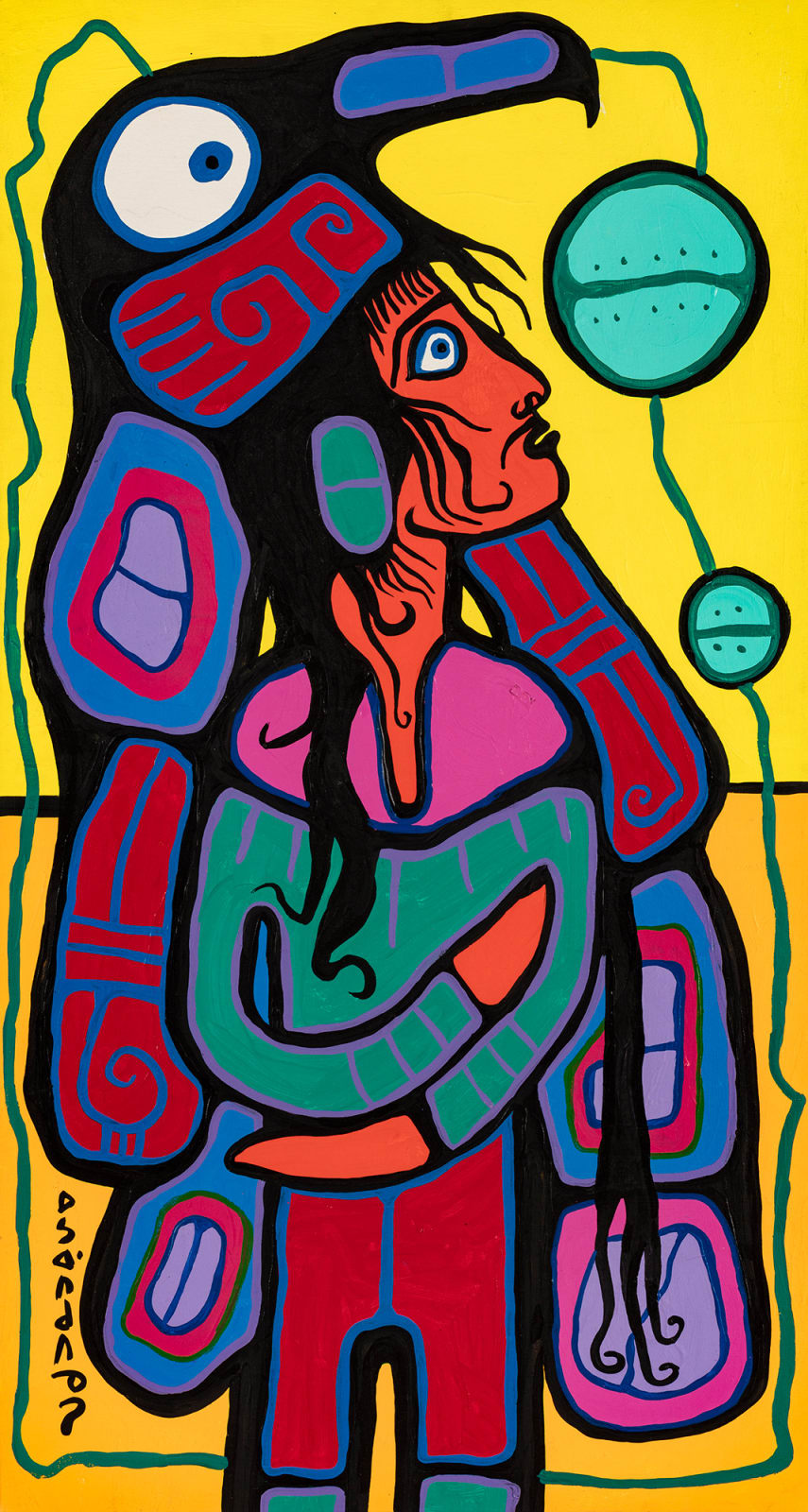-
Artworks
NORVAL MORRISSEAU, C.M. (1931-2007) ANISHINAABE
Young Ojibwa Indian Man Wearing Eagle Headdress, c. 1992acrylic on canvas, 52 x 28 in (132.1 x 71.1 cm), framed
signed, "ᐅᓴᐊ·ᐱᑯᐱᓀᓯ";
titled and inscribed in graphite by the artist, verso, "Young [Man, struck] Ojibwa Indian Man / wearing Eagl [sic] Headress [sic] / (16 yrs)".Lot 111
ESTIMATE: $20,000 — $30,000
PRICE REALIZED: $26,400.00Further images
In Young Ojibwa Indian Man Wearing Eagle Headdress, Norval Morrisseau paints an enchanting realm of solemnity and beauty. Dominated by his characteristic heavy black form lines and illuminated by a...In Young Ojibwa Indian Man Wearing Eagle Headdress, Norval Morrisseau paints an enchanting realm of solemnity and beauty. Dominated by his characteristic heavy black form lines and illuminated by a palette of jewel-like colours against yellow and orange, the vertical composition evokes the splendor of a stained-glass window. The figure's distinctively curled hairstyle reflects Morrisseau’s stylistic evolution from the mid-80s onwards, often anecdotally attributed to the influence of his close companion and caregiver, Gabe Vadas. Recognized by Don Robinson as "a stabilizing force in the artist’s life," Vadas's Elvis Presley-like coif became a noticeable motif in Morrisseau's subsequent works after their acquaintance [1].
In this work, the young man – with his gaze lifted and mouth slightly open, arms delicately folded – seems caught in a moment of quiet communion. The headdress, a traditional motif that is recurrent in Morrisseau’s oeuvre throughout his lengthy career, signifies a sacred bridge to the spirit world. Here, the boy wears an eagle headdress, symbolizing strength and foresight. The headdress envelops the youth, suggesting its role as guardian to the young man, guiding him and imparting wisdom.
1. Quoted in Carmen Robertson, Mythologizing Norval Morrisseau (Winnipeg: University of Manitoba Press, 2016), p. 141.
References: The most well-known example of a headdress featured in Morrisseau’s art is the six part series Man Changing into Thunderbird, 1977, from a Private Collection, on loan to the Art Gallery of Ontario, which is reproduced in Carmen Robertson, Norval Morrisseau: His Life & Work, (Toronto: Art Canada Institute, 2016), p. 30 and elsewhere. Several examples can also be seen in the work The Great Migration of the Ojibwa People, 1989, First Arts, 12 June 2023, Lot 63. For additional information on Morrisseau’s relationship with Gabor Vadas, see Carmen Robertson, Mythologizing Norval Morrisseau: Art and the Colonial Narrative in the Canadian Media, (Winnipeg: University of Manitoba Press, 2016), pp. 140-143; 159-160; 170-171.
Provenance
Acquired directly from the artist by the present Edmonton, Alberta Collection, c. 1990s.
Join our mailing list
* denotes required fields
We will process the personal data you have supplied in accordance with our privacy policy (available on request). You can unsubscribe or change your preferences at any time by clicking the link in our emails.






